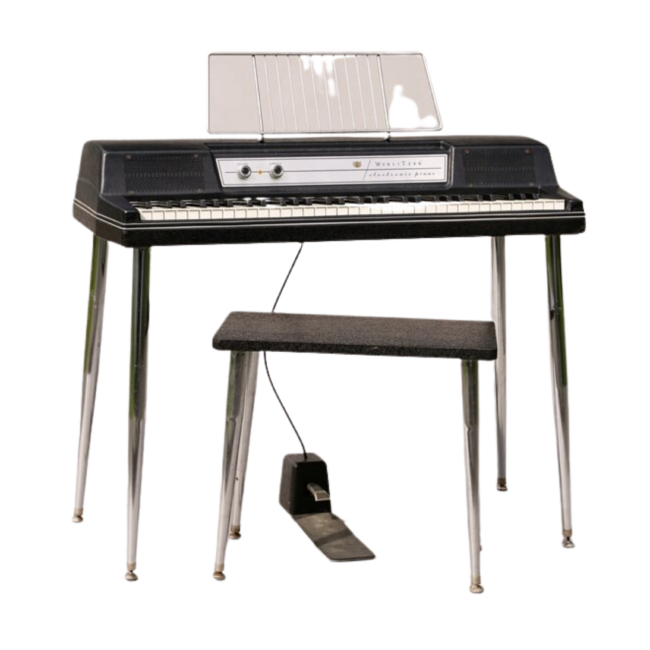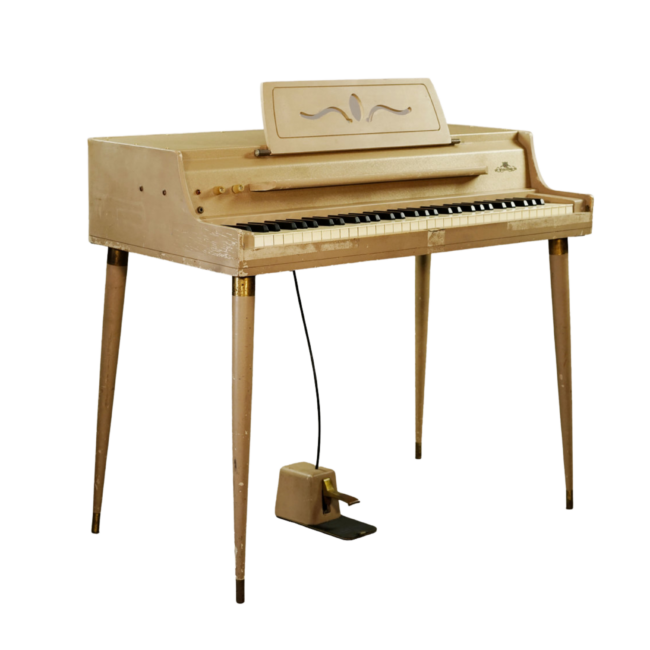All You Need to Know About Wurlitzer Pianos

In this article about Wurlitzer pianos, you will learn more about the history of this piano brand, its different models, and how to assess its true worth.
Every piano has a story—a brilliant craftsman, a small town, the magical sound of a hammer on a string that reverberates over decades into an empire of instruments that spreads across the globe.
In this article, we dive into the Wurlitzer history and help prepare you for buying one of your own.
If you’re interested in more, check out A Complete Piano History.

A brief history of the Wurlitzer pianos.
Let us paint you a picture–1853, Cincinnati, Ohio. A man with a name that would soon become internationally recognized, none other than Franz Rudolph Wurlitzer.
It started as a small operation, importing musical instruments from Germany to sell in the United States. Quickly it grew into a real entity, with a factory of its own built in 1861, producing melodeons and organs.
Two decades of successful growth followed until Wurlitzer finally began manufacturing pianos and selling them through their retail outlets.
The name spread like wildfire and peaked when Wurlitzer became one of the first defense contractors in the United States, providing instruments to the government during the Civil and Spanish-American Wars.
Beginning later in the same decade and until 1932, Wurlitzer produced band organs, stepping in to compensate for the tariffs imposed upon importing European-built organs.
The turn of the century brought many challenges for Wurlitzer, as it did for most businesses in that era. As challenges always do, they force you to think outside the box.

However, Wurlitzer decided to think inside the box! The original jukebox is called the Wurlitzer Simplex. As opposed to their pianos and organs, which were considered middle of the range, the jukeboxes and mechanical instruments became their new claim to fame.
The most common types of Wurlitzers.
Today, Wurlitzer is best known for its vintage electric piano. It was invented by radio engineer Benjamin Meissner, who took the conventional upright piano design, amplified it, and replaced the strings with struck steel reeds.

The earliest version to reach retail was the Wurlitzer 100, which had a heavy fiberboard case and a single speaker. Despite its weight, it was portable, as are all their electric piano models, and it had detachable legs.
During the 1950s, variations on the 100 were released, which used vacuum tube circuitry and featured a tremolo effect.
In the late 1960s came the release of the 200 models.

The 200 and the 200A are the most common models today. They use tubes that come in black, dark green, red, and beige. If you see a white Wurlitzer, it is either an earlier model or just painted white. So, don’t be fooled!
What is the average worth of a Wurlitzer piano?
It can be tricky to determine how much a Wurlitzer is worth. So let’s start with the best-case scenario.
If you’re buying a Wurlitzer 200A in bad condition or from somebody who doesn’t know what it is they’re selling, you might get lucky and find it for $800.
On the other end of the spectrum, a rare color of a Wurlitzer 200A without a scratch could sell for $6000.
In the middle range, you’ll find most black Wurlitzer 200As selling for around $2000. Many of them are old and require constant maintenance and tuning.
Things to consider when calculating the price of a Wurlitzer.
There are so many factors to consider when calculating the price of a Wurlitzer 200A. It’s essential to check them out before you pull out the big bucks. We’ll lay it all out for you right here:
How old is it?
Piano depreciates when you purchase it.
The market assumes a used piano has been played regularly, diminishing the quality of its components.
More desirable pianos and of higher quality, such as grand pianos, will have a slower depreciation rate.
If you’re unsure of your piano’s origins, try checking the serial number inside the piano. There are online resources for using the serial number to determine your piano’s age and origin—like a birth certificate.
How worn is it?
That goes for all instruments and humans too. With humans, it’s harder to compare, but with pianos, there are some basic questions:
Has the piano moved many times? Has it had more than one owner? What kind of living conditions was present in its previous home? Are there noticeable marks or scratches?
Make sure to examine your piano surgically before laying down the cash.
How tuned is it?
Tuning a piano can be expensive, especially a Wurlitzer 200A. Make sure you enquire about the piano’s tuning situation.
Has it been tuned recently? Regularly? Does it tend to fall out of tune?
If it hasn’t had a tuning in a long time, it may take more than one tuning session to bring it up to the correct pitch. In some situations, you may even need to replace the strings. Though these are not direct costs of your piano purchase, they are necessary expenses that may even be ongoing.
How’s the sound quality?
Pianos are more about sound than appearances. Sit down and play the instrument with patience and mindfulness. Play the keys with different temperaments and listen for the note’s resonance and attack.
Look inside the instrument and check for missing or damaged parts. You may notice some are replacements. If so, it could mean that more are in danger of falling or breaking soon.
Wurl itz a deal!
We hope you feel well informed after reading this article. You can never know everything about your instrument before purchasing it.
Use all the resources to ensure you get a high-quality instrument for a fair price. There’s a key ingredient we haven’t mentioned because it can’t be learned or acquired by your gut instinct.









